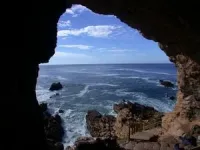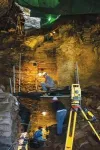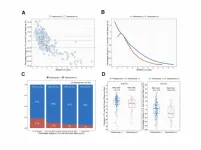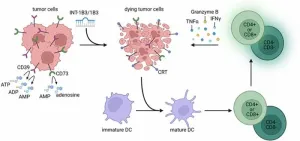(Press-News.org) At the edge of the south coast of South Africa, Arizona State University professor Curtis Marean and his research teams have been teasing out the secrets of our earliest modern human ancestors in caves at Pinnacle Point for over 25 years.
In late July, the site was declared a UNESCO World Heritage Site, the Olympic gold medal of heritage, which is only given to sites of “outstanding universal value” to all of humanity.
In 1999, while conducting reconnaissance on the south coast of South Africa, looking for a new field site to investigate ideas Marean had about the origins of modern humans, he explored a series of caves and rockshelters at the base of a 50-meter tall coastal cliff at Pinnacle Point. He saw high scientific potential in those sites, though they had never been excavated. In 2000, when he moved to ASU to join the Institute of Human Origins, he and his team did their first test excavations and commenced a research project that continues to reveal new and surprising clues about people living at the edge of the ocean from ~160,000 to 50,000 years ago.
In 2009, after successive breakthrough discoveries published in Nature and Science, Marean wondered how his team could use their scientific discoveries to give back to the local community that had so warmly welcomed and supported the researchers over the years. Marean decided to see if there was any opportunity for World Heritage Site recognition, since World Heritage sites can be potent drivers of tourism and job creation. He met with the mayor of the local town, Mossel Bay, and various stakeholders and members of the communities and began the process of surveys and information gathering. The group engaged the government of the Western Cape Province, which eventually took over the process and, crucially, appointed a full-time “champion” to run it, Dr. Mariagrazia Galimberti, who had done her PhD on Pinnacle Point materials. The application was submitted to UNESCO in March 2023, which was accepted on first submission! The formal announcement was made by UNESCO on July 26, 2024 from their meeting at New Delhi, India.
“Why does Pinnacle Point deserve World Heritage recognition? The research project itself is iconic in Quaternary — a period beginning 2.6 million years ago extending into the present — studies of climate and environment,” noted Marean. “Our research team has created a sophisticated narrative of human evolution embedded in a transdisciplinary study of changing climate and environment.”
“The history and adaptability of our species to change is essential to our understanding of all things,” said ASU President Michael Crow. “Pinnacle Point, with continuous human settlement for tens of thousands of years gives us that window into who we are and how we have adapted. It is a unique and unbelievable place that ASU will continue to use all we have to understand, and now as a world heritage site, its importance cannot be over stated.”
Their research has shown how a shift of looking at how humans survived from a focus solely on the land, to one embedded in the sea, had transformative impacts on the process of becoming human.
Outstanding research discoveries from the Pinnacle Point research team includes:
Pinnacle Point documents the earliest evidence for humans eating sea foods and developing an adaptation to the sea, dated to ~160,000 years ago, published in Nature 2007.
Early evidence for people modifying and working pigments, in this case red ochre, dated to ~160,000 years ago, published in Nature 2007.
The earliest evidence for pyrotechnology, using fire to modify raw materials, is from Pinnacle Point, dated to ~160,000 years ago, published in Science 2009.
The earliest evidence for a new advanced technology called microlithic technology is from Pinnacle Point, dated to ~71,000 years ago — good proxy evidence for the use of advanced projectile weapons — published in Nature 2012.
Pinnacle Point was the first site to show that humans thrived through the Mt. Toba super-volcanic eruption at ~74,000 years ago, published in Nature 2018.
“Professor Marean's decades-long research at Pinnacle Point is what brought the site into the limelight to be inscribed as World Heritage Site,” said Yohannes Haile-Selassie, director of the Institute of Human Origins.
“This project, and World Heritage recognition, would not have been possible without the ongoing support from Arizona State University, Institute of Human Origins, and the School of Human Evolution and Social Change, and the National Science Foundation and the Hyde Family Foundation,” added Marean. “In addition, this research was supported by an evolving team of some 60 scientists from eight countries, with hundreds of students—including South African students—gaining excavation and research experience, with many PhD research dissertations completed.”
“Pinnacle Point has proven to be an incredible insight into the origin of our species – particularly our relationship with the sea,” said Ryan Williams, director of the School of Human Evolution and Social Change. “It has also been a remarkable place for hands-on learning for numerous ASU anthropology students, from undergraduates to doctoral students. I am so proud of Curtis Marean for his tireless efforts to advance the understanding of this unique exemplar of the human experience and of our students who have been instrumental in advancing this work.”
During the past 10 years, Marean has also worked to build a modest outreach center in Mossel Bay called the Point Discovery Centre. His goal is a world-class information, outreach, and research center that will inform the local and international community of the science and stories told in the region but will require additional funding and long-term support to reach its full potential.
Marean and his team have many more research questions to tackle on the south coast, and he is excited to engage new emerging technologies that will help them do that. There is still much to learn about how our earliest modern human ancestors survived and thrived by the ocean as many other branches of our genus Homo went extinct.
END
Arizona State University research site designated UNESCO World Heritage Site
At the edge of the south coast of South Africa, Arizona State University professor Curtis Marean and his research teams have been teasing out the secrets of our earliest modern human ancestors in caves at Pinnacle Point for over 25 years.
2024-08-05
ELSE PRESS RELEASES FROM THIS DATE:
Association between osteoporosis and telomere shortening
2024-08-05
“We sought to identify an association between osteoporosis and LTL shortening in an independent prospective cohort.”
BUFFALO, NY- August 5, 2024 – A new research paper was published on the cover of Aging (listed by MEDLINE/PubMed as "Aging (Albany NY)" and "Aging-US" by Web of Science) Volume 16, Issue 14, entitled, “Association between osteoporosis and the rate of telomere shortening.”
A shorter leukocyte telomere length (LTL) is reported to be associated with age-related diseases, including osteoporosis. Many studies ...
DRI’s STEM education team receives EPA grant to support microplastics education for Nevada students and communities
2024-08-05
Reno, Nev. (August 5, 2024) – DRI’s STEM Education Team has received a grant from the Environmental Protection Agency (EPA) to support environmental education in Nevada’s schools.
The $100,000 grant will fund the production of additional educational kits known as Greenboxes that raise awareness and understanding of the prevalence and role of microplastics in the environment.
“DRI is honored to be awarded this EPA grant, and we are eager to continue our outreach to underserved rural and urban communities across Nevada,” said DRI STEM Education Program Manager Emily McDonald-Williams. “Middle school students ...
Sex bias in pain management at emergency departments new study reveals
2024-08-05
New study reveals a significant sex bias in pain management at emergency departments, showing that female patients are consistently less likely to receive pain medication prescriptions compared to male patients with similar complaints. This bias persists across different ages, pain levels, and physician sex, indicating a systemic issue. Female patients' pain scores are less frequently recorded, and they spend more time in the emergency department than male patients. The findings highlight the need for urgent policy interventions and training for healthcare ...
Child Mind Institute paper reveals next frontier in reproducible brain imaging for neuroscience discovery
2024-08-05
New York, NY (August 5, 2024) — The Child Mind Institute has released a paper detailing their pioneering study in the journal Nature Human Behaviour titled, "Moving Beyond Processing and Analysis-Related Variation in Resting State Functional Brain Imaging." The research identifies significant challenges in the reproducibility and standardization of functional magnetic resonance imaging (fMRI) used to understand brain function and behavior — and proposes concrete solutions to move the field towards results that translate into real world impact.
Along with a diverse team of international collaborators, ...
Hospital pneumonia diagnoses are uncertain, revised more than half the time, study finds
2024-08-05
Pneumonia diagnoses are marked by pronounced uncertainty, an AI-based analysis of over 2 million hospital visits has found.
More than half the time, a pneumonia diagnosis made in the hospital will change from a patient’s entrance to their discharge—either because someone who was initially diagnosed with pneumonia ended up with a different final diagnosis, or because a final diagnosis of pneumonia was missed when a patient entered the hospital (not including cases of hospital-acquired pneumonia).
The study describing the new results publishes August 6th in Annals of Internal Medicine.
Barbara Jones, MD, MSCI, pulmonary and critical care physician ...
Cancer screening estimated to cost $43 billion a year in the United States
2024-08-05
Embargoed for release until 5:00 p.m. ET on Monday 5 August 2024
Annals of Internal Medicine Tip Sheet
@Annalsofim
Below please find summaries of new articles that will be published in the next issue of Annals of Internal Medicine. The summaries are not intended to substitute for the full articles as a source of information. This information is under strict embargo and by taking it into possession, media representatives are committing to the terms of the embargo not only on their own behalf, but also on behalf of the organization they represent.
----------------------------
1. ...
Researchers receive 9.5 million grant to study relationship between polyphenol intake, Alzheimer’s prevention, and the brain-gut-microbiome system
2024-08-05
UCLA Health researchers, in collaboration with researchers from the Republic of Ireland and Northern Ireland, have received $9.5 million award from the National Institutes of Health (NIH) with support from European funding agencies — The Science Foundation Ireland (SFI) and the Public Health Agency Health & Social Care (HSC) — to study the effects of polyphenols on cognitive health and the brain-gut microbiome system.
The proposal, named MAEVE, stands for “Microbiota mediated flavonoid metabolites for cognitive health.”
In this interdisciplinary and multicenter study funded through the Tripartite US-Ireland Research & Development Partnership Program, ...
UH astronomers uncover risks to planets that could host life
2024-08-05
A groundbreaking study has revealed that red dwarf stars can produce stellar flares that carry far-ultraviolet (far-UV) radiation levels much higher than previously believed. This discovery suggests that the intense UV radiation from these flares could significantly impact whether planets around red dwarf stars can be habitable. Led by current and former astronomers from the University of Hawaiʻi Institute for Astronomy (IfA), the research was recently published in the Monthly Notices of the Royal Astronomical Society.
“Few stars have been thought to generate ...
An overlooked side-effect of the housing crisis may be putting Californians at increased risk from climate disasters
2024-08-05
In a new article for the journal Proceedings of the National Academy of Sciences, UC Santa Cruz researchers laid out the foundation for their highly-anticipated upcoming study of how lack of affordable housing in urban areas of California may be driving increased development in and near wildlands, leading to more severe climate change impacts.
Since the 1990s, California has led the nation in the growth of Wildland-Urban Interface (WUI) development, with more than one in three households in the state now located immediately next to or within ...
INT-1B3 miR-193a-3p mimic boosts t cell immunity and induces tumor cell death
2024-08-05
BUFFALO, NY- August 5, 2024 – A new research paper was published in Oncotarget's Volume 15 on July 12, 2024, entitled, “INT-1B3, an LNP formulated miR-193a-3p mimic, promotes anti-tumor immunity by enhancing T cell mediated immune responses via modulation of the tumor microenvironment and induction of immunogenic cell death.”
In this study, researchers Chantal L. Duurland, Thijs de Gunst, Harm C. den Boer, Marion T.J. van den Bosch, Bryony J. Telford, Rogier M. Vos, Xiaolei Xie, Mingfa Zang, Fang Wang, Yingying Shao, Xiaoyu ...
LAST 30 PRESS RELEASES:
Next-generation vision model maps tree growth at sub-meter precision
Genes aren’t destiny for inherited blindness, study shows
MIT study: High-fat diets make liver cells more likely to become cancerous
Exposure to multiple fine particulate matter components and incident depression in the US Medicare population
Risk of burdensome health care spending over time in the US
Nirsevimab against hospitalizations and emergency department visits for lower respiratory tract infection in infants
New microfluidics technology enables highly uniform DNA condensate formation
A new strategy for immune tolerance
Super Mario Bros. help fight burnout: New study links classic games to boosted happiness
Deepest gas hydrate cold seep ever discovered in the arctic: International research team unveils Freya Hydrate Mounds at 3,640 m depth.
Integrating light and structure: Smarter mapping for fragile wetland ecosystems
ACA-SIM: A robust way to decode satellite signals over complex waters
Probiotics can restore gut microbiome in breastfed infants
AI could help predict nutrition risks in ICU patients, study finds
Federal EITC has unexpected result, researchers say – it decreases domestic violence
Researchers identify gene that calms the mind and improves attention in mice
Artificial metabolism turns waste CO2 into useful chemicals
Ancient sea anemone sheds light on animal cell type evolution
Begging gene leads to drone food
How climate policies that incentivize and penalize can drive the clean energy transition
Can community awareness campaigns in low-resource areas improve early diagnosis of colorectal cancer?
Stardust study resets how life’s atoms spread through space
Practical education: Clinical scenario-based program development
The impact of family dynamics on eating behaviour – how going home for Christmas can change how you eat
Tracing the quick synthesis of an industrially important catalyst
New software sheds light on cancer’s hidden genetic networks
UT Health San Antonio awarded $3 million in CPRIT grants to bolster cancer research and prevention efforts in South Texas
Third symposium spotlights global challenge of new contaminants in China’s fight against pollution
From straw to soil harmony: International team reveals how biochar supercharges carbon-smart farming
Myeloma: How AI is redrawing the map of cancer care
[Press-News.org] Arizona State University research site designated UNESCO World Heritage SiteAt the edge of the south coast of South Africa, Arizona State University professor Curtis Marean and his research teams have been teasing out the secrets of our earliest modern human ancestors in caves at Pinnacle Point for over 25 years.







